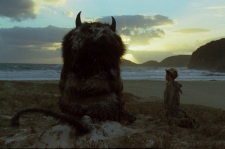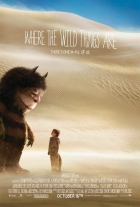Where the Wild Things Are
|  In his first feature film in eight years (and the first not from a Charlie Kaufman screenplay), Spike Jonze again returns to the thin line between fantasy and reality in adapting Maurice Sendak’s beloved 1963 children’s book Where the Wild Things Are. It is not entirely surprising that Jonze, who is something of a wild thing himself, would feel such affinity for Sendak’s ten-sentence flight of fancy in which an angry little boy is sent to his room without supper for threatening to eat his mother up and then imagines himself in a faraway land inhabited by towering monstrosities that he tames with a single glance. The challenge, of course, is making a feature-length film out of ten sentences and a handful of indelible illustrations, and Jonze and his screenwriting partner Dave Eggers do an admirable, and at times alchemic, job of transforming the slim volume into something decidedly weightier in terms of plot without sacrificing the essence of the book’s focus on the darker edges of childhood. In his first feature film in eight years (and the first not from a Charlie Kaufman screenplay), Spike Jonze again returns to the thin line between fantasy and reality in adapting Maurice Sendak’s beloved 1963 children’s book Where the Wild Things Are. It is not entirely surprising that Jonze, who is something of a wild thing himself, would feel such affinity for Sendak’s ten-sentence flight of fancy in which an angry little boy is sent to his room without supper for threatening to eat his mother up and then imagines himself in a faraway land inhabited by towering monstrosities that he tames with a single glance. The challenge, of course, is making a feature-length film out of ten sentences and a handful of indelible illustrations, and Jonze and his screenwriting partner Dave Eggers do an admirable, and at times alchemic, job of transforming the slim volume into something decidedly weightier in terms of plot without sacrificing the essence of the book’s focus on the darker edges of childhood.Jonze and Eggers keep the basic scenario, but add in details that help explain why young Max (Max Records) feels so alone in the world. He has an older sister (Pepita Emmerichs) who is clearly not interested in him, and his well-meaning, but work-addled mother (Catherine Keener), who is either divorced or widowed, has turned much of her remaining attention to a new boyfriend (Mark Ruffalo). Jonze sketches in these dynamics in quick, broad strokes, just enough to give us a sense of Max’s life and explain why he finally explodes and takes off into the land of the wild things. Jonze gives the book’s logic an important tweak at this point, depicting Max running off down the street and finding the boat that will take him to the wild things instead of imagining his room growing into a jungle. While this denies the film one of the book’s most memorable images of the power of childhood imagination to literally swallow reality, it also muddies the divide between the real and the imaginary, possibly suggesting that the wild things are physically present, rather than daydream projections. Visually, Jonze and cinematographer Lance Acord (who also shot Jonze’s previous two features, 1999’s Being John Malcovich and 2001’s Adaptation.) open up the world of the wild things, giving us beautiful images of both dense jungles and rolling, wide-open deserts that are as vast as the psyche they are meant to evoke (one of the film’s true strengths is the way it makes the fantastical feel real and lived-in and literal without losing the sense of fantasy). The wild things--they of the “terrible roars” and “terrible teeth”--are brought to life with an impressive combination of physical puppetry and digital effects that makes them seem powerfully real. Unlike in the book, each wild thing is given a distinct personality that, in some facet, reflects Max. Voiced by the likes of James Gandolfini, Catherine O’Hara, Forest Whitaker, Chris Cooper, and Lauren Ambrose, among others, the wild things are a conflicted, fragmented bunch searching for some kind of unity and coherence, which they think they find in Max. Thus, like their young leader, the wild things reflect the confusion and insecurity that comes with being young and inexperienced and not always in control of your feelings, and their enormous size and fearsome appearance makes a striking and ironic counterpoint to their emotional immaturity. Many critics have read the wild things as dysfunctional in the adult sense of the term, and that seems to me to be missing the point. Like Max, they are children, even if they seem huge and imposing in the way that Max, decked out in his ragged wolf pajamas, would like to see himself. Thus, there is a deep poignancy to the wild things and their interactions with Max, because he is essentially interacting with all those darker parts of himself. That’s a pretty heavy load for an ostensible children’s film to bear, and some parents may be right in their complaints that Where the Wild Things Are is too dark or scary or emotionally complicated for little ones. In fact, part of the problem with the film’s reception may be the misplaced assumption that it is a children’s film, rather than a film about childhood, which seems to be what Jonze is gunning for. The film has the same emotional hooks and underlying themes of the book, but they’re packaged in a larger, more complicated form that challenges conventional expectations of what a kids’ film looks and sounds like. Cinematically, Where the Wild Things Are is nothing short of beautiful and at times profound. If there is a weakness, it is that Jonze and Eggers stretch the material a bit farther than it needs to go, resulting in a middle section that loses steam, although it picks up again in the final reel when Max, as he did in the book, realizes where true love and acceptance lie. For all its emphasis on escaping into the fantastical realm of pure anarchy, Jonze’s film, like Sendak’s book, is ultimately about the warmth of coming home. Copyright ©2009 James Kendrick Thoughts? E-mail James Kendrick All images copyright © Warner Bros. |
Overall Rating: 


 (3.5)
(3.5)


